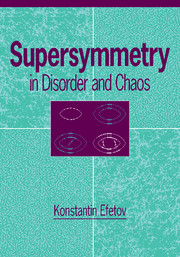Book contents
- Frontmatter
- Contents
- Preface
- Acknowledgments
- 1 Introduction
- 2 Supermathematics
- 3 Diffusion modes
- 4 Nonlinear supermatrix σ-model
- 5 Perturbation theory and renormalization group
- 6 Energy level statistics
- 7 Quantum size effects in small metal particles
- 8 Persistent currents in mesoscopic rings
- 9 Transport through mesoscopic devices
- 10 Universal parametric correlations
- 11 Localization in systems with one-dimensional geometry
- 12 Anderson metal–insulator transition
- 13 Disorder in two dimensions
- 14 Afterword
- Appendix 1 Calculation of the Jacobian
- Appendix 2 Magnetic field parametrization
- Appendix 3 Density–density correlation function at k = 0
- Appendix 4 Effective medium approximation as a saddle point
- References
- Author index
- Subject index
8 - Persistent currents in mesoscopic rings
Published online by Cambridge University Press: 10 November 2010
- Frontmatter
- Contents
- Preface
- Acknowledgments
- 1 Introduction
- 2 Supermathematics
- 3 Diffusion modes
- 4 Nonlinear supermatrix σ-model
- 5 Perturbation theory and renormalization group
- 6 Energy level statistics
- 7 Quantum size effects in small metal particles
- 8 Persistent currents in mesoscopic rings
- 9 Transport through mesoscopic devices
- 10 Universal parametric correlations
- 11 Localization in systems with one-dimensional geometry
- 12 Anderson metal–insulator transition
- 13 Disorder in two dimensions
- 14 Afterword
- Appendix 1 Calculation of the Jacobian
- Appendix 2 Magnetic field parametrization
- Appendix 3 Density–density correlation function at k = 0
- Appendix 4 Effective medium approximation as a saddle point
- References
- Author index
- Subject index
Summary
Basic properties
The recent observations of persistent currents in small metallic rings by Lévy et al. (1990), Chandrasekhar et al. (1991), and Mailly, Chapelier, and Benoit (1993) have opened a new field of research. Although small mesoscopic systems have been under intensive study for quite a long time, they have usually been studied by making contacts with metallic leads. As a result, one could obtain a finite conductance of the system that corresponded to a finite current in the presence of a finite voltage only. The experiments by Lévy et al. (1990) and by Chandrasekhar et al. (1991) were carried out in such a way that the metallic rings remained isolated. A slowly varying magnetic field was applied and a magnetic response was measured. In this situation it became possible to observe persistent currents in quite dirty samples in which the elastic mean free path l was much shorter than the circumference L. The existence of the persistent current is possible in isolated rings only, and Mailly, Chapelier, and Benoit (1993) demonstrated how the value of the persistent current decreases when increasing a weak coupling to leads.
The intriguing question of persistent currents in metal rings enclosing a magnetic flux was discussed in the 1960s by Byers and Yang (1961), F. Bloch (1965, 1968, 1970), Schick (1968), Gunter and Imry (1969).
- Type
- Chapter
- Information
- Supersymmetry in Disorder and Chaos , pp. 152 - 188Publisher: Cambridge University PressPrint publication year: 1996



